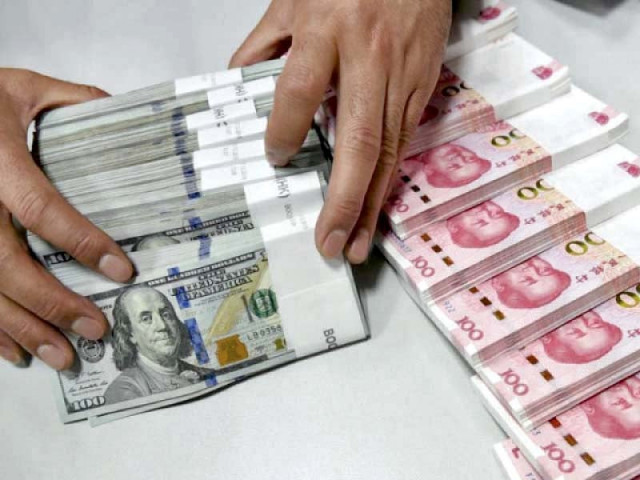Currency swap facility costs Rs36.3b
Burden may increase further as Pakistan asks China to raise the facility’s ceiling

The cost of a $4.5 billion Chinese currency swap facility for repaying debt went up by 39% to a record Rs36.3 billion in the last fiscal year, a burden that will increase further as Pakistan has requested China to augment the facility’s size.
Annual financial accounts of the State Bank of Pakistan (SBP) for financial year 2021-22 disclosed that Pakistan paid Rs36.3 billion in interest on using the $4.5 billion Chinese trade finance facility.
In the preceding fiscal year, the country had paid Rs26.1 billion in interest cost, which increased by 39%, or Rs10.2 billion, in one year.
The SBP report revealed that the central bank fully tapped the $4.5 billion, or 30 billion yuan, trade finance facility under the China-Pakistan currency swap arrangement.
A bilateral currency swap agreement (CSA) was struck between the SBP and the People’s Bank of China in December 2011 to promote bilateral trade, foreign direct investment, provide short-term liquidity support and for any other purpose mutually agreed between the two central banks.
During fiscal year 2021, the overall limit of 20 billion yuan was extended to 30 billion yuan, or $4.5 billion, for a period of three years against the equivalent amount in Pakistani rupees with maturity buckets of three months to one year, according to the central bank.
Finance Minister Ishaq Dar visited China this month and requested the Chinese prime minister to further increase the trade finance facility by 10 billion yuan, or $1.5 billion. He sought the increase in ceiling after loans from the bilateral and multilateral creditors did not arrive.
In case of increase in the facility, the interest cost may jump to around Rs50 billion in the current fiscal year.
Every successive government has failed to ensure non-debt-creating inflows, leading to a situation where the country is now heavily counting on foreign sources to stay afloat.
In rupee terms, the bilateral currency swap value increased from Rs748.5 billion in the preceding year to Rs927 billion by June this year, an increase of Rs186 billion, according to the central bank.
Out of the Rs927 billion, the interest-bearing component was Rs918 billion, said the SBP.
Pakistan largely utilised the Chinese trade finance facility to repay foreign debt and keep its foreign currency reserves at levels that could stave off panic in markets.
The $4.5 billion facility is part of the SBP’s foreign exchange reserves of around $8 billion.
China has also extended $4 billion in SAFE deposits, which are also part of the foreign currency reserves. In addition to that, China has given commercial loans.
Pakistan’s foreign exchange reserves of $8 billion are even lower than the country’s debt obligations to China.
China has recently shown its frustration over Pakistan’s inability to protect its citizens and failure to honour commitments given under the China-Pakistan Economic Corridor (CPEC) framework agreement.
The benefit of the currency swap facility is that the Chinese loan is not reflected in the federal government books and it is not treated as a part of Pakistan’s external public debt.
The government is facing difficulties in securing the next loan tranche of $1.2 billion from the International Monetary Fund (IMF) due to disagreement over the impact on budget of the recent floods and the unfulfilled commitments.
The rupee has again come under pressure and traded at over Rs223 to a dollar, far above the target of less than 200 set by Finance Minister Ishaq Dar for himself.
The delay in securing dates for an IMF staff-level visit could also undermine programme loans from other multilateral creditors, which were critical for maintaining the foreign exchange reserves at current levels.
The SBP statement revealed that the central bank’s auditors raised some concern about the quality of Rs2.2 trillion worth of SBP’s assets placed in foreign currency accounts.
According to a note of the auditors, “the existence and valuation of these foreign currency accounts and investments were assessed by us as a significant risk area and therefore we considered this as a key audit matter”.
The assets of Rs2.2 trillion include “balances aggregating to Rs426.4 billion, which were placed through the appointed fund managers by the bank under the supervision of a custodian”, according to the statement.
Despite a significant increase in interest income, the central bank’s profit fell by Rs11 billion to Rs746 billion in the last fiscal year.
Published in The Express Tribune, November 20th, 2022.
Like Business on Facebook, follow @TribuneBiz on Twitter to stay informed and join in the conversation.


















COMMENTS
Comments are moderated and generally will be posted if they are on-topic and not abusive.
For more information, please see our Comments FAQ